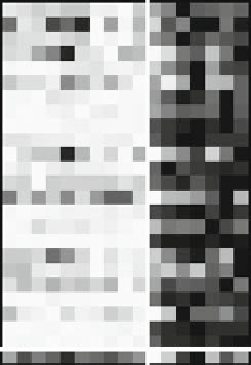Information Technology Reference
In-Depth Information
NAME
fp1
fp2
fp3
fp4
c3
c
p4
o1
o2
f7
f8
t
t4
t5
t
a1
a2
f
cz
pz
pz
leye
reye
lmn
rmn
p3
NAME
f7
t6
t3
leye
reye
t3
Fig. 6.2: Heatmaps for patients A and B.
6.5 Conclusions
In this review, the formal definitions of biclustering with its different types and
structures are given and the algorithms are reviewed in mathematical prospective.
Biclustering is recently a hot research area with its applications in bioinformat-
ics. Other application areas are text mining, marketing analysis, etc. In practical
applications, some problems, such as the data missing, the noise of data, and data
processing, influence a lot to the results of biclustering. Besides, the comparisons of
biclustering algorithms are still another direction to be studied.
References
1. Angiulli, F., Cesario, E., Pizzuti, C. Random walk biclustering for microarray data. Inf Sci:
Int J
178
(6), 1479-1497 (2008)
2. Barkow, S., et al. BicAT: A biclustering analysis toolbox. Bioinformatics
22
, 1282-1283
(2006)
3. Ben-Dor, A., Chor, B., Karp, R., Yakhini, Z. Discovering local structure in gene expression
data: The order-preserving submatrix problem. J Comput Biol
10
, 373-384 (2003)
4. Busygin, S., Prokopyev, O.A., Pardalos, P.M. Feature selection for consistent biclustering via
fractional 0-1 programming. J Comb Optim
10
/1, 7-21 (2005)
5. Busygin, S., Prokopyev, O.A., Pardalos, P.M. Biclustering in datamining. Comput Oper Res
35,
2964-2987 (2008)
6. Busygin, S., Boyko, N., Pardalos, P., Bewernitz, M., Ghacibehc, G. Biclustering EEG data
from epileptic patients treated with vagus nerve stimulation. AIP Conference Proceedings of
the Data Mining, Systems Analysis and Optimization in Biomedicine, 220-231 (2007)
7. Califano, A., Stolovitzky, G., Tu, Y. Analysis of gene expression microarays for phenotype
classification. Proceedings of International Conference on Computational Molecular Biology,
75-85 (2000)










